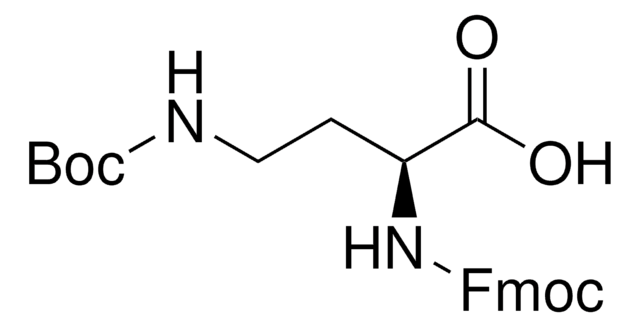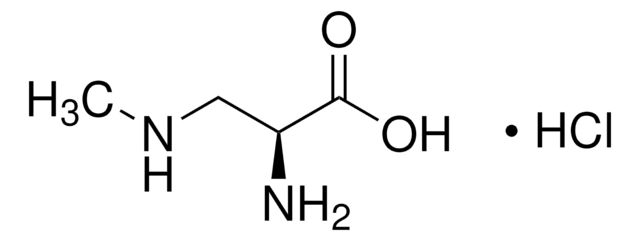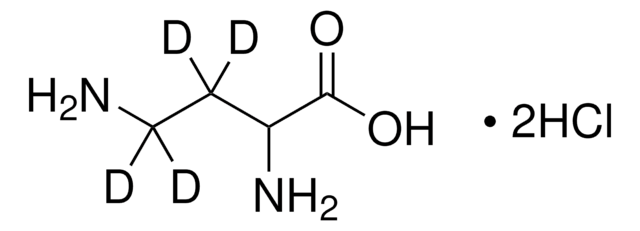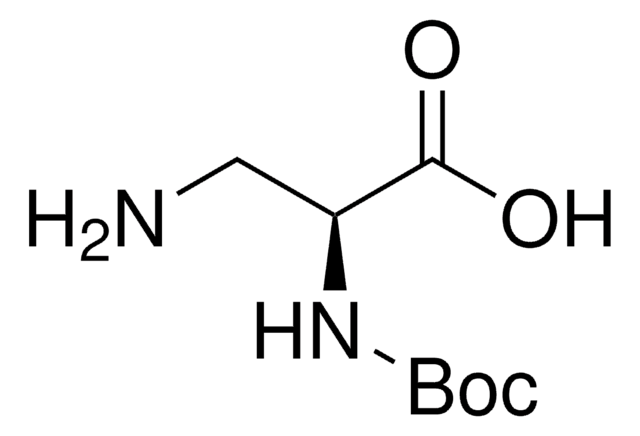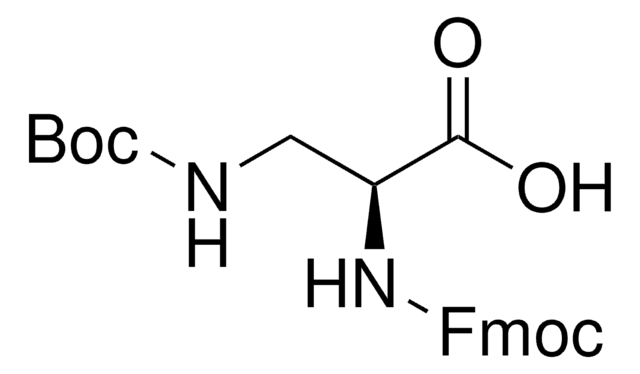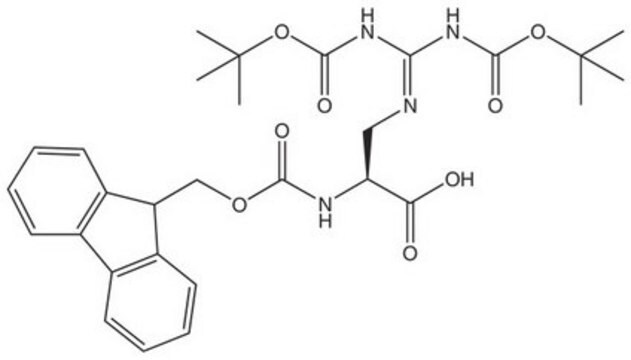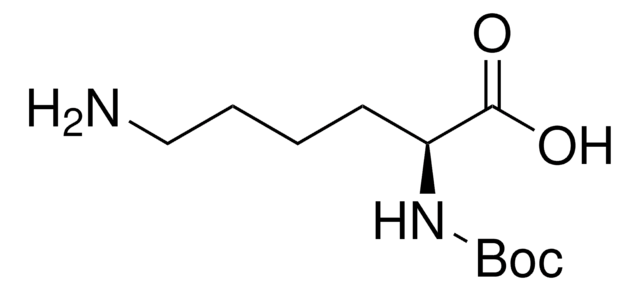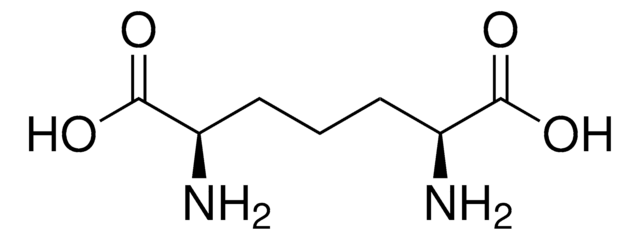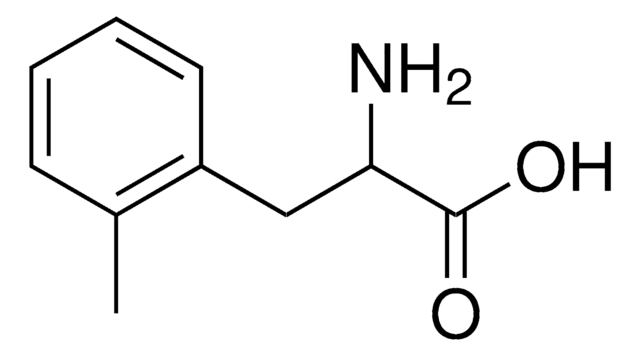32830
L-2,4-Diaminobutyric acid dihydrochloride
≥95.0%
동의어(들):
(2S)-2,4-Diaminobutanoic acid dihydrochloride, L-2,4-Diaminobutanoic acid dihydrochloride
로그인조직 및 계약 가격 보기
모든 사진(1)
About This Item
Linear Formula:
NH2CH2CH2CH(NH2)COOH · 2HCl
CAS Number:
Molecular Weight:
191.06
Beilstein:
5763078
EC Number:
MDL number:
UNSPSC 코드:
12352106
PubChem Substance ID:
NACRES:
NA.22
추천 제품
Quality Level
분석
≥95.0% (AT)
≥95.0%
광학 활성
[α]20/D +14.5±1.5°, c = 3.67% in H2O
반응 적합성
reaction type: solution phase peptide synthesis
mp
197-200 °C (dec.)
solubility
water: soluble 0.5 g/10 mL
응용 분야
peptide synthesis
SMILES string
Cl.Cl.NCC[C@H](N)C(O)=O
InChI
1S/C4H10N2O2.2ClH/c5-2-1-3(6)4(7)8;;/h3H,1-2,5-6H2,(H,7,8);2*1H/t3-;;/m0../s1
InChI key
CKAAWCHIBBNLOJ-QTNFYWBSSA-N
유사한 제품을 찾으십니까? 방문 제품 비교 안내
일반 설명
L-2,4-Diaminobutyric acid dihydrochloride is an unnatural amino acid derivative.
애플리케이션
L-2,4-Diaminobutyric acid dihydrochloride is suitable reagent used for the differentiation of β-N-methylamino-L-alanine from the diamino acids by using HPLC-FD, UHPLC-UV, UHPLC-MS, and triple quadrupole tandem mass spectrometry (UHPLC-MS/MS). It is suitable reagent used in the quantification of neurotoxin β-N-methylamino-L-alanine (BMAA) in seafood. It may be used as Internal standard for amino acid analysis
주의사항
may give off HCl
신호어
Danger
유해 및 위험 성명서
예방조치 성명서
Hazard Classifications
Eye Dam. 1 - Skin Irrit. 2 - STOT SE 3
표적 기관
Respiratory system
Storage Class Code
11 - Combustible Solids
WGK
WGK 3
Flash Point (°F)
Not applicable
Flash Point (°C)
Not applicable
개인 보호 장비
dust mask type N95 (US), Eyeshields, Gloves
가장 최신 버전 중 하나를 선택하세요:
Liying Jiang et al.
Scientific reports, 4, 6931-6931 (2014-11-07)
The neurotoxin β-N-methylamino-L-alanine (BMAA) produced naturally by cyanobacteria, diatoms and dinoflagellates can be transferred and accumulated up the food chain, and may be a risk factor for neurodegenerative diseases. This study provides the first systematic screening of BMAA exposure of
Discovery of α,β- and α,γ-diamino acid scaffolds for the inhibition of M1 family aminopeptidases.
Rajesh Gumpena et al.
ChemMedChem, 6(11), 1971-1976 (2011-10-26)
Thomas Krüger et al.
Toxicon : official journal of the International Society on Toxinology, 55(2-3), 547-557 (2009-10-15)
Since diverse taxa of cyanobacteria has been linked to biosynthesis of BMAA, a controversy has arisen about the detection of neurotoxic amino acids in cyanobacteria. In this context, a novel LC-MS/MS method was developed for the unambiguous determination of beta-N-methylamino-L-alanine
Maria Hoernke et al.
Biochimica et biophysica acta, 1818(7), 1663-1672 (2012-03-22)
Basic amino acids play a key role in the binding of membrane associated proteins to negatively charged membranes. However, side chains of basic amino acids like lysine do not only provide a positive charge, but also a flexible hydrocarbon spacer
S A Banack et al.
Toxicon : official journal of the International Society on Toxinology, 56(6), 868-879 (2010-06-22)
The cyanobacterial neurotoxin beta-N-methylamino-L-alanine (BMAA) has been associated with certain forms of progressive neurodegenerative disease, including sporadic Amyotrophic Lateral Sclerosis and Alzheimer's disease. Reports of BMAA in cyanobacterial blooms from lakes, reservoirs, and other water resources continue to be made
자사의 과학자팀은 생명 과학, 재료 과학, 화학 합성, 크로마토그래피, 분석 및 기타 많은 영역을 포함한 모든 과학 분야에 경험이 있습니다..
고객지원팀으로 연락바랍니다.
